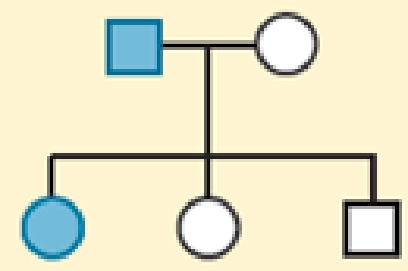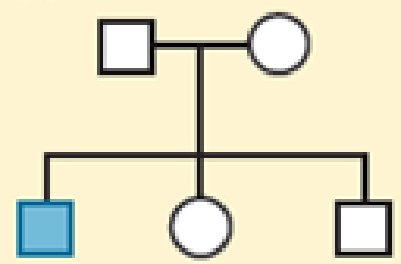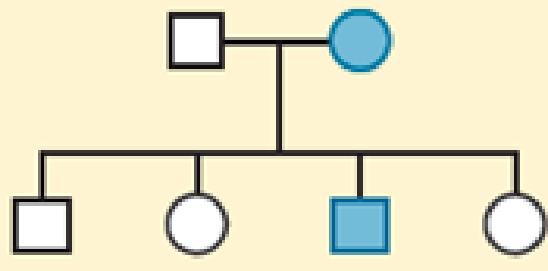
Concepts of Genetics (12th Edition)
12th Edition
ISBN: 9780134604718
Author: William S. Klug, Michael R. Cummings, Charlotte A. Spencer, Michael A. Palladino, Darrell Killian
Publisher: PEARSON
expand_more
expand_more
format_list_bulleted
Concept explainers
Textbook Question
Chapter 4, Problem 3NST
Below are three pedigrees. For each trait, consider whether it is or is not consistent with X-linked recessive inheritance. In a sentence or two, indicate why or why not.



Expert Solution & Answer
Want to see the full answer?
Check out a sample textbook solution
Students have asked these similar questions
Please indentify the unknown organism
Please indentify the unknown organism
Please indentify the unknown organism
Chapter 4 Solutions
Concepts of Genetics (12th Edition)
Ch. 4 - In the guinea pig, one locus involved in the...Ch. 4 - In some plants a red flower pigment, cyanidin, is...Ch. 4 - Below are three pedigrees. For each trait,...Ch. 4 - Researching their family histories, a deaf couple...Ch. 4 - Researching their family histories, a deaf couple...Ch. 4 - HOW DO WE KNOW? In this chapter, we focused on...Ch. 4 - CONCEPT QUESTION Review the Chapter Concepts list...Ch. 4 - In shorthorn cattle, coat color may be red, white,...Ch. 4 - In foxes, two alleles of a single gene, P and p,...Ch. 4 - In mice, a short-tailed mutant was discovered....
Ch. 4 - List all possible genotypes for the A, B, AB, and...Ch. 4 - With regard to the ABO blood types in humans,...Ch. 4 - In a disputed parentage case, the child is blood...Ch. 4 - The A and B antigens in humans may be found in...Ch. 4 - In chickens, a condition referred to as creeper...Ch. 4 - In rabbits, a series of multiple alleles controls...Ch. 4 - Three gene pairs located on separate autosomes...Ch. 4 - As in Problem 12, flower color may be red, white,...Ch. 4 - Horses can be cremello (a light cream color),...Ch. 4 - With reference to the eye color phenotypes...Ch. 4 - Pigment in mouse fur is only produced when the C...Ch. 4 - In rats, the following genotypes of two...Ch. 4 - Given the inheritance pattern of coat color in...Ch. 4 - In a species of the cat family, eye color can be...Ch. 4 - In a plant, a tall variety was crossed with a...Ch. 4 - In a unique species of plants, flowers may be...Ch. 4 - Five human matings (15), identified by both...Ch. 4 - A husband and wife have normal vision, although...Ch. 4 - In humans, the ABO blood type is under the control...Ch. 4 - In Drosophila, an X-linked recessive mutation,...Ch. 4 - Another recessive mutation in Drosophila, ebony...Ch. 4 - In Drosophila, the X-linked recessive mutation...Ch. 4 - While vermilion is X-linked in Drosophila and...Ch. 4 - In a cross in Drosophila involving the X-linked...Ch. 4 - Consider the three pedigrees below, all involving...Ch. 4 - In goats, the development of the beard is due to a...Ch. 4 - Predict the F1 and F2 results of crossing a male...Ch. 4 - Two mothers give birth to sons at the same time at...Ch. 4 - Discuss the topic of phenotypic expression and the...Ch. 4 - Prob. 35PDQCh. 4 - Labrador retrievers may be black, brown...Ch. 4 - A true-breeding purple-leafed plant isolated from...Ch. 4 - In Dexter and Kerry cattle, animals may be polled...Ch. 4 - A geneticist from an alien planet that prohibits...Ch. 4 - The following pedigree is characteristic of an...Ch. 4 - Students taking a genetics exam were expected to...Ch. 4 - In four oclock plants, many flower colors are...Ch. 4 - Below is a partial pedigree of hemophilia in the...
Additional Science Textbook Solutions
Find more solutions based on key concepts
Why do scientists think that all forms of life on earth have a common origin?
Genetics: From Genes to Genomes
True or false? Some trails are considered vestigial because they existed long ago.
Biological Science (6th Edition)
Describe the role and impact of microbes on the earth.
Microbiology Fundamentals: A Clinical Approach
Identify me theme or themes exemplified by (a) the sharp quills of a porcupine (b) the development of a multice...
Campbell Biology in Focus (2nd Edition)
Single penny tossed 20 times and counting heads and tails: Probability (prediction): _______/20 heads ________/...
Laboratory Manual For Human Anatomy & Physiology
Knowledge Booster
Learn more about
Need a deep-dive on the concept behind this application? Look no further. Learn more about this topic, biology and related others by exploring similar questions and additional content below.Similar questions
- Please indentify the unknown organismarrow_forward5G JA ATTC 3 3 CTIA A1G5 5 GAAT I I3 3 CTIA AA5 Fig. 5-3: The Eco restriction site (left) would be cleaved at the locations indicated by the arrows. However, a SNP in the position shown in gray (right) would prevent cleavage at this site by EcoRI One of the SNPs in B. rapa is found within the Park14 locus and can be detected by RFLP analysis. The CT polymorphism is found in the intron of the Bra013780 gene found on Chromosome 1. The Park14 allele with the "C" in the SNP has two EcoRI sites and thus is cleaved twice by EcoRI If there is a "T" in that SNP, one of the EcoRI sites is altered, so the Park14 allele with the T in the SNP has only one EcoRI site (Fig. 5-3). Park14 allele with SNP(C) Park14 allele with SNPT) 839 EcoRI 1101 EcoRI 839 EcoRI Fig. 5.4: Schematic restriction maps of the two different Park14 alleles (1316 bp long) of B. rapa. Where on these maps is the CT SNP located? 90 The primers used to amplify the DNA at the Park14 locus (see Fig. 5 and Table 3 of Slankster et…arrow_forwardFrom your previous experiment, you found that this enhancer activates stripe 2 of eve expression. When you sequence this enhancer you find several binding sites for the gap gene, Giant. To test how Giant interacts with eve, you decide to remove all of the Giant binding sites from the eve enhancer. What results do you expect to see with respect to eve expression?arrow_forward
- What experiment could you do to see if the maternal gene, bicoid, is sufficient to form anterior fates?arrow_forwardYou’re curious about the effect that gap genes have on the pair-rule gene, evenskipped (eve), so you isolate and sequence each of the eve enhancers. You’re particularly interested in one of the enhancers, which is just upstream of the eve gene. Describe an experimental technique you would use to find out where this particular eve enhancer is active.arrow_forwardFor short answer questions, write your answers on the line provided. To the right is the mRNA codon table to use as needed throughout the exam. First letter U บบบ U CA UUCPhe UUA UCU Phe UCC UUG Leu CUU UAU. G U UAC TV UGCys UAA Stop UGA Stop A UAG Stop UGG Trp Ser UCA UCG CCU] 0 CUC CUA CCC CAC CAU His CGU CGC Leu Pro CCA CAA Gin CGA Arg CUG CCG CAG CGG AUU ACU AAU T AUC lle A 1 ACC Thr AUA ACA AUG Mot ACG AGG Arg GUU GCU GUC GCC G Val Ala GAC Asp GGU GGC GUA GUG GCA GCG GAA GGA Gly Glu GAGJ GGG AACASH AGU Ser AAA1 AAG Lys GAU AGA CAL CALUCAO CAO G Third letter 1. (+7) Use the table below to answer the questions; use the codon table above to assist you. The promoter sequence of DNA is on the LEFT. You do not need to fill in the entire table. Assume we are in the middle of a gene sequence (no need to find a start codon). DNA 1 DNA 2 mRNA tRNA Polypeptide C Val G C. T A C a. On which strand of DNA is the template strand (DNA 1 or 2)?_ b. On which side of the mRNA is the 5' end (left or…arrow_forward
- 3. (6 pts) Fill in the boxes according to the directions on the right. Structure R-C R-COOH OH R-OH i R-CO-R' R R-PO4 R-CH3 C. 0 R' R-O-P-OH 1 OH H R-C-H R-N' I- H H R-NH₂ \H Name Propertiesarrow_forward4. (6 pts) Use the molecule below to answer these questions and identify the side chains and ends. Please use tidy boxes to indicate parts and write the letter labels within that box. a. How many monomer subunits are shown? b. Box a Polar but non-ionizable side chain and label P c. Box a Basic Polar side chain and label BP d. Box the carboxyl group at the end of the polypeptide and label with letter C (C-terminus) H H OHHO H H 0 HHO H-N-CC-N-C-C N-C-C-N-GC-OH I H-C-H CH2 CH2 CH2 H3C-C+H CH2 CH2 OH CH CH₂ C=O OH CH2 NH2arrow_forwardplease answer (A,B,C,D,E) questions with the asnwer choice provided below. thank you!arrow_forward
arrow_back_ios
SEE MORE QUESTIONS
arrow_forward_ios
Recommended textbooks for you
 Human Biology (MindTap Course List)BiologyISBN:9781305112100Author:Cecie Starr, Beverly McMillanPublisher:Cengage Learning
Human Biology (MindTap Course List)BiologyISBN:9781305112100Author:Cecie Starr, Beverly McMillanPublisher:Cengage Learning
 Human Heredity: Principles and Issues (MindTap Co...BiologyISBN:9781305251052Author:Michael CummingsPublisher:Cengage Learning
Human Heredity: Principles and Issues (MindTap Co...BiologyISBN:9781305251052Author:Michael CummingsPublisher:Cengage Learning Biology: The Dynamic Science (MindTap Course List)BiologyISBN:9781305389892Author:Peter J. Russell, Paul E. Hertz, Beverly McMillanPublisher:Cengage Learning
Biology: The Dynamic Science (MindTap Course List)BiologyISBN:9781305389892Author:Peter J. Russell, Paul E. Hertz, Beverly McMillanPublisher:Cengage Learning Biology (MindTap Course List)BiologyISBN:9781337392938Author:Eldra Solomon, Charles Martin, Diana W. Martin, Linda R. BergPublisher:Cengage Learning
Biology (MindTap Course List)BiologyISBN:9781337392938Author:Eldra Solomon, Charles Martin, Diana W. Martin, Linda R. BergPublisher:Cengage Learning Biology Today and Tomorrow without Physiology (Mi...BiologyISBN:9781305117396Author:Cecie Starr, Christine Evers, Lisa StarrPublisher:Cengage Learning
Biology Today and Tomorrow without Physiology (Mi...BiologyISBN:9781305117396Author:Cecie Starr, Christine Evers, Lisa StarrPublisher:Cengage Learning

Human Biology (MindTap Course List)
Biology
ISBN:9781305112100
Author:Cecie Starr, Beverly McMillan
Publisher:Cengage Learning


Human Heredity: Principles and Issues (MindTap Co...
Biology
ISBN:9781305251052
Author:Michael Cummings
Publisher:Cengage Learning

Biology: The Dynamic Science (MindTap Course List)
Biology
ISBN:9781305389892
Author:Peter J. Russell, Paul E. Hertz, Beverly McMillan
Publisher:Cengage Learning

Biology (MindTap Course List)
Biology
ISBN:9781337392938
Author:Eldra Solomon, Charles Martin, Diana W. Martin, Linda R. Berg
Publisher:Cengage Learning

Biology Today and Tomorrow without Physiology (Mi...
Biology
ISBN:9781305117396
Author:Cecie Starr, Christine Evers, Lisa Starr
Publisher:Cengage Learning
Mitochondrial mutations; Author: Useful Genetics;https://www.youtube.com/watch?v=GvgXe-3RJeU;License: CC-BY